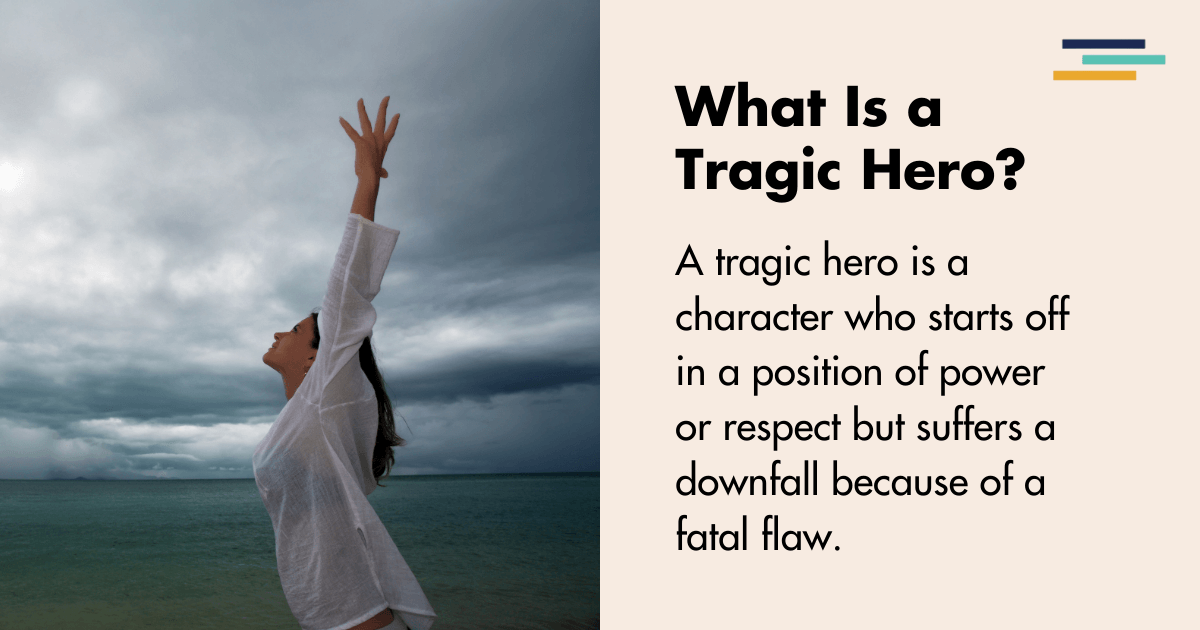
Ah, the tragic hero.
One of literature’s most interesting and enduring character archetypes.
If you’ve ever felt a pang of sorrow for a character’s unfortunate fate, chances are you’ve encountered a tragic hero. But what exactly is a tragic hero? How do you create one? And what are some stellar examples from literature?
Fear not, because this article will answer all your questions and more. By the end, you’ll be armed with all the tools you need to craft your own unforgettable tragic hero.
What Is a Tragic Hero in Literature?
Tragic Hero Definition
A tragic hero is a character who starts off in a position of power or respect but suffers a downfall because of a fatal flaw (often hubris or excessive pride).
Misfortune marks this character’s journey, suffering, and ultimately, a tragic end. Despite their flaws, tragic heroes often earn the audience’s sympathy because of their admirable qualities and the inevitability of their fate.
The tragic hero’s story arc typically follows a path from greatness to downfall, illustrating the human condition’s complexities and the consequences of personal flaws and societal pressures. These characters are not purely villains or saints. Their multifaceted nature makes them relatable and profoundly human.
By witnessing their struggles and downfalls, readers gain insight into their own lives and the broader human experience.

Tragic Hero Meaning
The term “tragic hero” comes from the Greek word “tragos,” which means goat, and “ode,” which means song.
Together, they refer to ancient Greek tragedies, where protagonists often faced dire consequences because of their flaws. This concept has developed over centuries but keeps its core essence.
A character whose greatest strengths are also their undoing.
Ancient Greek playwrights like Sophocles and Euripides first defined the tragic hero archetype, but it has since transcended cultures and eras, appearing in countless works of literature, theater, and even film.
The tragic hero’s enduring appeal lies in the universal themes of ambition, fate, and the human condition, which resonate across time and place.
Tragic Hero Characteristics
Creating a tragic hero is like baking a complex dessert (think soufflé, not brownie).
Here are the key ingredients:
- Noble Stature: Tragic heroes often hold a prominent position in society, which makes their fall more impactful. Think kings, generals, or respected leaders. This noble stature isn’t limited to royalty or the elite. It can also refer to a character’s inner nobility or moral standing within their community.
- Hamartia (Fatal Flaw): This is the trait that leads to the hero’s downfall. Common flaws include hubris (excessive pride), ambition, or jealousy. The fatal flaw isn’t necessarily a vice. It can be an excess of a virtue, like unwavering loyalty or relentless pursuit of justice, which becomes detrimental under certain circumstances.
- Peripeteia (Reversal of Fortune): At some point, the hero’s fortune takes a dramatic turn for the worse, usually because of their own actions. This reversal is often sudden and stark, highlighting the precariousness of human existence and the thin line between success and disaster.
- Anagnorisis (Recognition): The hero realizes their flaw and its consequences, often too late to change their fate. This moment of clarity is crucial, as it underscores the inevitability of their downfall and adds a layer of poignancy to their story.
- Catharsis: The audience feels a sense of emotional purging or relief after experiencing the hero’s journey, despite its tragic outcome. This emotional release makes tragic stories so interesting, allowing readers to confront and process their own fears and anxieties.
- Inevitable Downfall: Despite their efforts, the tragic hero cannot escape their fate. The very qualities that make them admirable seal their end. This inevitability is often foreshadowed throughout the story, creating a sense of impending doom that keeps readers engaged.

Tragic Hero Examples
Oedipus from Oedipus Rex by Sophocles
Oedipus is the quintessential tragic hero.
Born to a royal family, he rises to become the King of Thebes. His fatal flaw, hubris, leads him to kill his father and marry his mother. Despite his efforts to avoid this fate, Oedipus’ downfall is inevitable, and his recognition of his actions leads to his tragic end.
Sophocles masterfully uses dramatic irony to enhance the tragedy of Oedipus’ story.
The audience knows Oedipus’ true parentage and the prophecy that foretold his fate, creating a sense of dread as the hero’s actions bring him closer to the inevitable truth.
Oedipus’ journey from ignorance to knowledge, and from pride to despair, epitomizes the tragic hero’s arc.
Hamlet from Hamlet by William Shakespeare
Prince Hamlet is another classic tragic hero.
His noble stature as the Prince of Denmark and his fatal flaw, indecision, lead to his downfall. Hamlet’s quest for revenge against his uncle, who killed his father, spirals into a tragedy that results in the deaths of almost every main character, including himself.
Hamlet’s introspective nature and existential dilemmas add depth to his character, making him one of literature’s most complex tragic heroes.
His famous soliloquy, “To be, or not to be,” encapsulates his internal struggle and the broader human condition. Hamlet’s tragic end, brought about by his own hesitation and the machinations of those around him, leaves the audience reflecting on the consequences of inaction and the inevitability of fate.
Macbeth from Macbeth by William Shakespeare
Macbeth’s ambition and the manipulations of his wife, Lady Macbeth, lead him to his downfall. His desire for power leads him to murder King Duncan and take the throne, but this act sets off a chain of events that culminates in his own death.
Macbeth’s descent into tyranny and madness is a gripping portrayal of how unchecked ambition can corrupt even the noblest of characters.
Shakespeare’s exploration of guilt, fate, and the supernatural adds layers of complexity to Macbeth’s story. His tragic end, marked by a desperate fight to keep his ill-gotten power, serves as a cautionary tale about the perils of overreaching ambition.
Jay Gatsby from The Great Gatsby by F. Scott Fitzgerald
Jay Gatsby, though not of noble birth, rises to great wealth and status through questionable means.
His fatal flaw, his obsessive love for Daisy Buchanan, leads to his tragic end. Gatsby’s dream of recreating the past and winning Daisy’s love ultimately results in his downfall.
Gatsby’s idealism and pursuit of the American Dream are central to his character.
Fitzgerald uses Gatsby’s tragic arc to critique the hollowness of material success and the unattainable nature of the American Dream. Gatsby’s death, brought about by his misplaced trust and unfulfilled desires, evokes a profound sense of loss and disillusionment.
Willy Loman from Death of a Salesman by Arthur Miller
Willy Loman is a tragic hero of a different sort. As an average person, his noble stature comes from his role as a father and husband.
His fatal flaw is his unwavering belief in the American Dream and his delusions of grandeur. Willy’s realization of his failures comes too late, leading to his tragic end.
Arthur Miller redefined the tragic hero with Willy Loman, emphasizing that tragedy can befall ordinary people, not just the noble or powerful. Willy’s relentless pursuit of success and his inability to adapt to changing circumstances highlight the destructive nature of societal pressures and personal delusions.
His tragic end, marked by a sense of unfulfilled potential and familial discord, resonates deeply with readers.

Tips for Writing the Tragic Hero Archetype
Creating a tragic hero isn’t just about ticking boxes. It’s about crafting a character who resonates with readers on a deep emotional level.
Here are some tips to help you achieve that.
Understand Their Flaw
Get to the heart of your tragic hero’s fatal flaw.
What drives them? What do they desire most? How does this desire lead to their downfall? Understanding these elements will make your character more complex and relatable.
Consider how this flaw influences their decisions and interactions with other characters.
Is it a flaw they’re aware of but unable to control, or is it something they don’t recognize until it’s too late? This internal conflict can add depth to your character and make their journey more engaging.
Make Them Sympathetic
Despite their flaws, your tragic hero should have qualities that make readers root for them. This could be their bravery, intelligence, or a noble goal.
The key is to balance their admirable traits with their fatal flaw.
Show moments of vulnerability and humanity in your tragic hero. These moments can create a sense of empathy and connection with the reader. Highlight their good intentions, even if their actions lead to negative outcomes. This duality makes the character more three-dimensional and interesting.
Plan Their Downfall
A tragic hero’s downfall should feel inevitable yet avoidable.
This paradox creates tension and keeps readers engaged. Plan the events that lead to their downfall carefully, ensuring each step feels logical and earned.
Incorporate external factors, such as societal pressures or manipulative characters, that influence the hero’s decisions and contribute to their downfall. This adds complexity to the narrative and underscores the interconnectedness of personal and external forces in shaping the hero’s fate.
Use Subtle Foreshadowing
Foreshadowing can add depth to your tragic hero’s journey.
Drop hints about their fatal flaw and eventual downfall throughout your story. This creates a sense of impending doom that keeps readers hooked.
Use symbolism and motifs to reinforce the hero’s journey and foreshadow their fate.
For example, a recurring image or phrase can serve as a reminder of the hero’s flaw and the consequences it will bring. This technique enriches the narrative and creates a cohesive and immersive reading experience.
Show Their Recognition
Anagnorisis (the point in a play, novel, etc., in which a principal character recognizes or discovers another character’s true identity or the true nature of their own circumstances) is a powerful moment in any tragic hero’s story.
Show your hero’s realization of their flaw and its consequences in a way that evokes powerful emotions. This moment should be poignant and transformative.
Use dialogue, inner monologue, or significant events to convey the hero’s recognition. This moment should be a turning point in the narrative, where the hero’s understanding of themselves and their actions shifts dramatically. It can also serve as a catalyst for the final stages of their journey, leading to their ultimate downfall.
Evoke Catharsis
Your readers should feel a sense of catharsis after experiencing your tragic hero’s journey. This emotional release makes tragic stories so interesting.
Aim to evoke a mix of pity, fear, and relief in your readers.
Create scenes that allow readers to connect with the hero’s internal struggles and the external consequences of their actions.
This emotional engagement fosters a deeper connection with the story and amplifies the cathartic experience. Use vivid descriptions and evocative language to heighten the emotional impact of key moments.
Keep It Real
Even though tragic heroes often come from noble backgrounds, their struggles should be relatable.
Ground their journey in genuine emotions and motivations readers can connect with.
Explore universal themes such as love, ambition, jealousy, and pride. These themes resonate with readers because they reflect fundamental aspects of the human experience. By rooting your tragic hero’s journey in these relatable emotions and motivations, you create a character that feels authentic.
Balance Strengths and Weaknesses
A well-crafted tragic hero has both strengths and weaknesses.
Their strengths should be significant enough to make their downfall tragic, while their weaknesses should be enough to make it inevitable.
Highlight the hero’s positive qualities and how they contribute to their initial success and noble stature. Emphasize how these same qualities become detrimental in certain situations.
This balance creates a nuanced character whose downfall feels both tragic and inevitable.
Avoid Overused Tropes
While certain elements of the tragic hero archetype are timeless, try to avoid clichés. Give your hero unique traits and a fresh story to make them stand out.
Consider subverting traditional tropes or incorporating unexpected elements into your tragic hero’s story.
For example, you could explore a contemporary setting or a non-traditional background, adding layers of complexity and originality to the narrative. This approach keeps the story fresh and engaging for readers.
Don’t Rush Their Journey
A tragic hero’s story is a slow burn.
Take your time to develop their character, build up their strengths, and gradually reveal their flaws. This pacing will make their downfall more impactful.
Allow space for the hero’s internal and external struggles to unfold naturally.
This gradual development creates a sense of inevitability and allows readers to become deeply invested in the character’s journey. Use subplots and supporting characters to enrich the narrative and add depth to the hero’s story.
Explore Different Perspectives
Consider incorporating different perspectives to add depth to your tragic hero’s story.
This can include the viewpoints of supporting characters, antagonists, or even a narrator. These perspectives can provide additional insights into the hero’s actions, motivations, and the impact of their downfall.
By exploring different perspectives, you can create a richer and more layered narrative that enhances the reader’s understanding of the tragic hero and their journey. This approach also allows you to highlight the broader implications of the hero’s actions and the interconnectedness of their fate with the lives of others.
Reflect on Modern Tragic Heroes
While classical tragic heroes often come from noble backgrounds, modern literature has expanded the archetype to include characters from diverse backgrounds and experiences.
Reflect on how contemporary issues and societal changes can shape the tragic hero’s journey.
Consider how themes such as identity, mental health, and social justice can influence your tragic hero’s story. By addressing relevant and timely issues, you create a character that resonates with modern readers and reflects the complexities of contemporary life.
And there you have it.
By following these tips, you’ll be well on your way to creating a tragic hero that captivates readers and leaves a lasting impression.
And finally, always remember that story comes first. Focus on:
- Creating engaging characters
- Penning interesting plots
- Structuring solid settings
A tool like Fictionary helps you turn your draft into an interesting story readers love. So, with a strong narrative foundation, your writing can truly shine.


